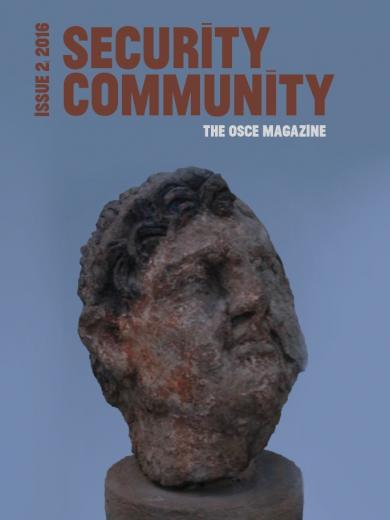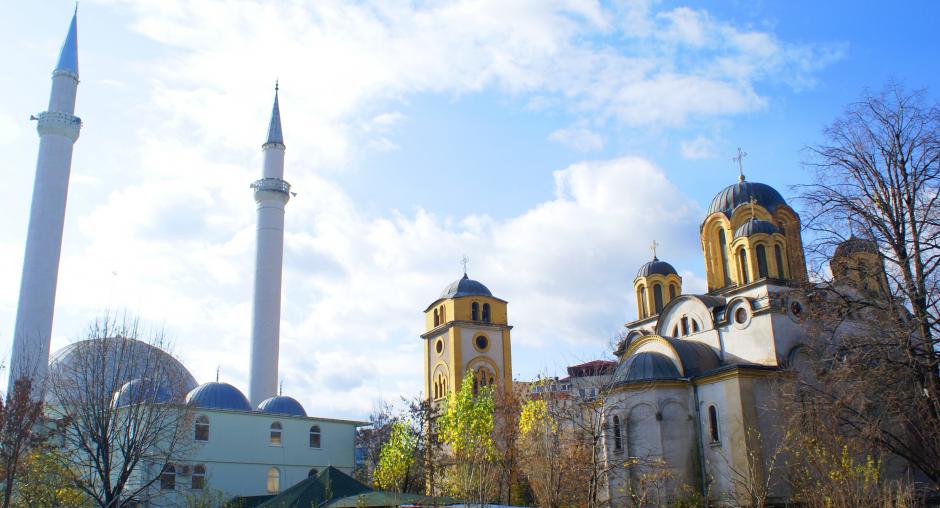Building Blocks for Peace: Cultural Heritage Protection in Kosovo
By Päivi Nikander and Valerie Zirl
"Culture stands on the front-line of conflict – it should be at the front-line of peace building.” - UNESCO Director General Irina Bokova
The 1998/99 Kosovo conflict, like many modern armed conflicts, was an identity-based confrontation, the result of a dispute between groups of society formed over a common culture. On both sides, cultural and religious monuments were specifically targeted as visual symbols belonging to the other group. Hundreds of mosques and other Islamic religious sites, historic bazars and a large number of kullas, traditional Albanian stone houses, as well as Serbian Orthodox religious monuments were damaged or destroyed during and after the conflict. When inter-ethnic violence briefly but intensely resurged in March 2004, Serbian Orthodox churches and monasteries in different areas became the target of attacks by rioting groups of Albanians.
While traditional conflict-resolution methods are primarily tailored to address differences of interest between states, identity-based conflicts require a new approach. In Kosovo, cultural heritage protection had to become an intrinsic element of the peace-building process.
Initial measures
In the immediate aftermath of the conflict, the international community focused on the physical protection of religious and cultural sites. In 1999, the NATO peacekeeping forces secured the most prominent Serbian Orthodox monasteries. In 2003, the United Nations Mission in Kosovo (UNMIK) named the preservation of cultural heritage as one of the benchmarks to be achieved by the provisional institutions of self-government in Kosovo. Alarmed by the resurgence of ethnic violence in 2004, the international community the following year pledged US$10 million for the protection of cultural and religious heritage sites at a donor conference organized by UNESCO together with the Council of Europe and the European Commission.
Safeguards for the protection of religious and cultural heritage were included among the guiding principles of the Kosovo status process initiated by the UN Security Council in 2005. The 2007 Comprehensive Proposal for the Kosovo Status Settlement contained an annex with protection mechanisms. Although the adoption of the proposal as a peace treaty failed, most of the provisions were later adopted, after Kosovo institutions unilaterally declared independence in 2008. The most important were the establishment of special protective zones around more than 40 Serbian Orthodox sites and the establishment of an Implementation and Monitoring Council, a high-level dialogue platform bringing together the Serbian Orthodox leadership with the Kosovo government to discuss issues affecting these zones.
The OSCE and the Council of Europe supported the Kosovo institutions in developing the necessary legal and institutional framework for heritage protection. Until today, a European Union representative co-chairs the Implementation and Monitoring Council meetings, while the OSCE provides technical expertise.
From protection to reconciliation
Installing legal and institutional mechanisms to protect the rights of former opponents to the symbols of their cultural identity was but a first step towards reconciliation in Kosovo. However, even this first step required an immense effort on the part of community leaders and international peace builders. Effective implementation was protracted over years, hampered by a lack of political support and inadequate financial and human resources. A buy-in by the Serbian Orthodox Church into the process required extensive international advocacy. Cultural heritage protection was not a fast-selling item.
Still, the mechanisms the international community introduced were able to trigger a number of positive developments. Importantly, these have gone beyond the mere protection of physical sites to initiate a process of dialogue and reconciliation.
After the Implementation and Monitoring Council began to meet on a regular basis in early 2013, members of the Serbian Orthodox Church also increasingly participated in local level meetings together with central and local government representatives. Leaders of all religious beliefs in Kosovo entered into an OSCE-sponsored inter-ethnic dialogue process to jointly advocate for the protection of religious freedom.
Municipalities are assuming more and more responsibility for ensuring that the law applicable within protective zones is respected. Ever more frequently, Kosovo Albanian mayors and local governments interact with the Serbian Orthodox communities in their municipalities. The fact that Kosovo Albanian officials – mayors, ministers and even the president – are increasingly visiting Serbian Orthodox sites and participating in the Serbian Orthodox Church’s religious festivities is a major milestone in the development of a constructive relationship between the communities.
In another big step forward, the Kosovo Police established a special unit trained to secure the most vulnerable sites and have taken over almost all security responsibilities from the international community.
There have also been setbacks. Vandalism and desecration of Serbian Orthodox churches, cemeteries and monasteries have a substantial impact on the Kosovo Serb community’s perception of security. This violence is committed by a small portion of the Kosovo Albanian community, but a larger number will ascertain that their community never received an apology or reparations for the destruction of Albanian sites in Kosovo during the conflict. Regardless of what the reasons may be, the Kosovo Serb community will not see a sustainable future for itself if it cannot live and express its cultural identity without fear. Incidents like the desecration of Orthodox cemeteries in retaliation for the demolition of an Albanian monument in southern Serbia, threatening graffiti sprayed on walls and doors of Serbian Orthodox monasteries or stones thrown at Serbian Orthodox pilgrims visiting religious sites clearly demonstrate how fragile any rapprochement between the communities is and how quickly cultural heritage can again become the target of hate crimes. Landowners who struggle with the difficult economic situation often lack understanding for the restrictions to their property rights within special protective zones.
Even after more than fifteen years of international engagement, more needs to be done to ensure sustainable cultural heritage protection and to consolidate effective safeguards for cultural identities in Kosovo. The challenge remains to transform what was seen as symbols of different identities into the bricks for building bridges between divided communities.
OSCE Engagement
The OSCE Mission in Kosovo, established in 1999 as “Pillar III” of UNMIK and primarily mandated to establish democratic institutions, rule of law agencies and human rights protection mechanisms after the conflict, today increasingly includes religious and cultural heritage protection initiatives in its programmes. “Because religion is such an important part of ethnic identity even though the conflict in Kosovo wasn’t religious but ethnic in nature, a lot of these religious heritage sites were destroyed or damaged in the conflict and its aftermath. For the same reason, rebuilding them and protecting them is a significant element in achieving reconciliation and a lasting peace,” says Head of Mission Ambassador Jean-Claude Schlumberger.
With a team of resident experts at its headquarters in Prishtinë/Priština and in its field offices across Kosovo, the OSCE Mission monitors developments around cultural heritage sites and, with the information collected, supports the work of the Implementation and Monitoring Council. It engages in mediation efforts between religious and political community leaders, supporting dialogue and offering a neutral problem-solving platform at both central and local levels.
The Mission particularly encourages women to participate in inter-religious dialogue and religious and cultural heritage protection. Not only does this provide valuable employment opportunities, it is also necessary for effective peace building. Women who lost loved ones during the conflict or became victims of violence themselves are an essential part of any peace process.
The Mission also pays attention to the important role young people can play in building confidence and tolerance among multicultural communities. Through art competitions like the 2015 photography contest, it brings together students of different communities to promote a sense of shared heritage and dismantle common stereotypes regarding “the others”. It thereby complements educational projects of the Council of Europe, the European Union and local NGOs such as Cultural Heritage without Borders. Students participating in visits to cultural and religious heritage sites are often exposed to the culture of other ethnic groups in their immediate neighbourhood for the first time. Children of all communities visiting cultural and religious heritage sites across Kosovo – and their parents supporting such initiatives – are encouraging signals that walls are starting to crumble.
Worth the effort
The Kosovo experience shows that cultural heritage protection is a necessary element of the peace-building process after an identity-based conflict, not only because cultural symbols were a target during conflict. Proactively using cultural heritage protection to bridge ethnic and religious differences is a necessary precondition for sustainable peace in a society whose members attribute crucial importance to elements of their cultural identity.
Protection mechanisms that give equal importance to the cultural and religious heritage of all communities are likely to find the broadest public support and thus be the most effective. If the rules of special protective zones in Kosovo were also applied to more than a handful of non-Orthodox sites, land owners would find it much harder to blame a specific community for unfair treatment and impediments to their socio-economic development.
Cultural heritage management should go beyond mere preservation. It has value for local economic development, not only as a stimulus for tourism, but also in the creation of employment opportunities in the restoration, conservation, management and promotion of heritage sites. If members of all communities are involved in and directly benefit from this process, they are likely to gradually appreciate the value of cultural heritage regardless of its religious or ethnic affiliation. Smart cultural heritage management also specifically targets young people as future caretakers.
In the long run, cultural heritage may even contribute to the development of a joint Kosovo identity that leaves religious or ethnic affiliation aside. Here, the international community has a certain responsibility and soft power. For a positive impact among members of the public, it will be crucial that the international community recognizes the equal and universal value of the heritage of the different communities in Kosovo, for example through the inclusion of sites representing the cultural heritage of all communities on the UNESCO World Heritage list. Such international recognition could well contribute to the communities taking pride in Kosovo’s cultural heritage and eventually losing sight of to whom it belongs.
Päivi Nikander is Deputy Head of the OSCE Mission in Kosovo. Valerie Zirl served as political adviser to the Head of the OSCE Mission in Kosovo for more than five years.
Welcome to Security Community
Security Community is the OSCE’s online space for expert analysis and personal perspectives on security issues.
The views expressed in the articles are those of the authors and do not necessarily reflect the official position of the OSCE and its participating States.


